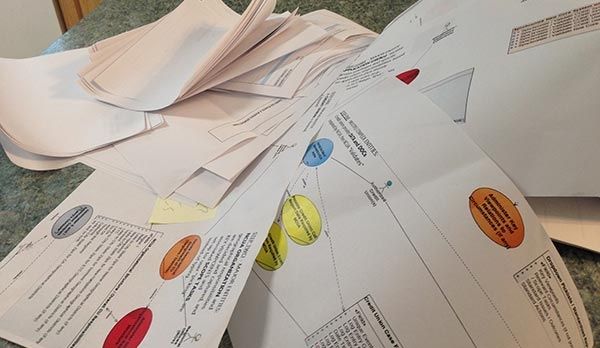BA-elzebub’s Glossary Three – The ‘A’s
My brilliant readers know this piece of fun. Get credit in my next blog by offering “B”s in the comments at bottom.
A, CY: Don’t make me spell it out for you 🙂
AAA: See Alcoholic Analysts Anonymous.
Aardvark: Unlikely boundary to BA-elzebub’s Glossary (see “AAA”).
Absolute Zero: Numeric, one byte datum probably not created by accident, but maybe.
Accuracy: Not the same as precision, nor validity (usefulness or applicability). Don’t make me Google it for you!
Acronym: ASCWTEACOTTIAFWSATD (A short clear way to express a concept or thought that insiders are familiar with, such as this definition).
Adipose: Part of a satisfied stakeholder’s state, as in “Adipose and anti-sad.”(YOU Google for “happy” synonyms)
Aeon: Amount of time it takes to deliver “everything” as asked.
Afferent: A better word to use than “olfactory” when describing a project. Example: “When we started this project it was relevant, but now it is positively afferent!”
Agenda: A personal secret goal, distinct from, and more important than, the purposes of the meeting.
Agile: Quick enough to dodge reading, duck writing, and stick to binary ‘rithmetic.
Agreement: A formal misunderstanding adopted for the common good.
Ahora: Cuando quieren la sistema (See “Ayer”).
Aim: Business activity typically following “Fire, Ready”.
Aimless: See “Aim”.
Airball: A word from basketball. Also, what an ‘airy cat ‘acks up at ‘ome. Why, what were YOU thinking?
Ajar: The only word (Scrabble Dictionary EVIL) beginning with “Aj”.
Akinesia: Motionlessness due to a paralysis (of analysis? – See “Analist”).
Alcoholic Analysts Anonymous: Likely boundary condition on BA-elzebub.
Ambiguous: Examples:
- Can Can
- Quality Test
- Assumed Risks
- Technology Constraints
- User Friendly
Also, one who is able to “take guous or leave it.” Not to be confused with Bi-guous or Bi-guouscurious (The “B’s have begun!).
Analist: Any list longer than people will actually read.
Analysis: Thought.
Analysis, Business: Somehow different from thought.
Analysis, Business, Monkey (MBA): See “Software Purchased on Golf Courses.”
Analysis, Data: Plural form of “Analysis, Datum”.
Analysis, Enough: Would choke a horse (See the artwork “Body of Work” at top).
Analysis, Strategic (nee Enterprise): “Find what’s broken that can’t be spoken.”
Analysis, Business, System: Fixing golfware at 50X the cost of “Analysis, Business.” Also – definition of “pay me later” in the popular colloquialism.
Analysis, Psycho: For that special “someone” stakeholder.
Analyst, Psycho: “Stake” holder for that special someone.
Analytics: The idea that increasing the amount of “garbage in” will – what exactly?
Aorist: Tense in ancient Greece, indicating a past activity that is done, with no reference to any structure, beginning, middle or end. Example: “The Ionian Peninsula Project (ancient Greece), made me nuts” (Tense – see how it works ). In this “tense” the event is one whole unit, all over and done (perfective). As opposed to “It made me nuts not knowing how the ionian Peninsula project was doing last Julius / Augustus” (imperfective) (You can look it up! Thanks Wikipedia!)
Aorta: The second word starting with “Ao”, including all its variants.
Aoudad: The third word starting with “Ao” (that’s all folks – beat “Aj” by two).
Approach, Solution: With great care, always asking it to “Put the spaghetti down and step away from the door.”
Aqua: Standard windows color, the use of which is almost always over-use (See “MAN!, Aqua, AGAIN?!”
Architecture, Network: Cisco Kid, was a friend of mine (please, no calls, I try).
Architecture, Software: See “Vaporlayer-ware”.
As-Is: A factual state of operations with as many versions as there are stakeholders (See “Az-Iz”).
Askew: Major requirements gap, as in “I’m not goin’ askew”.
At-Last: Project deadline that can always be reached (See “Expectations, Managing Without Getting Caught” for other examples.
Automation: A business solution approach that is worth doing (one that doesn’t move your cheese).
Auto-automation: When computers design and build computer systems.
Auto-auto-automation: When computers design and build self-driving cars.
Auto-auto-auto-automation: When cars design and build self-driving cars.
Auto-auto-auto-auto-auto-automation: When cars design and build self-driving cars for themselves (ba-da-BOOM! cymbal crash – yeah, really, it’s true, deny it if you can in the comments below, AND/OR get credit for defining the successor, which DOES EXIST :))
Autocrashtic: The voice telling you where to turn while you drive, having crossed its fine print when you agreed to the GPS’ license.
Automated: Obsolete, needing improvement.
Automatic: Not as automatic as you think (See “Automated”).
Aver: To state a requirement with plausible credibility –
Example: “Programming in modules will increase reliability.”
Averse: To state a requirement with plausible rhyme-ability –
Example: “Programming in modules will stimulate nodules.”
Avoid: A requirements gap resulting from sponsors cancelling meetings.
Awake, Network: Hypothetical ability of certain energy saving network printers.
Awesome: Last ditch attempt to influence a sponsor. Example: “Aw, some stakeholders are better than none.”
Ax, Can Hurt to: “The BA asked the CEO “why”, and got the ax.”
Ayer: Cuando quieren los requisitos para la sistema.
Az-Iz: A distant product owner with as many aversions as there are stakeholders (see “As-Is”).
Enjoy! And give BA-elzebub (not me!) some “B’s” below should your Brain Burst Bubbling with BA-slanguage Bonanzas of BA-rbarisms 🙂
How about definitions for Baseline? Button? Best Practice? Box? Benchmark?
Don’t forget to leave your comments below.

